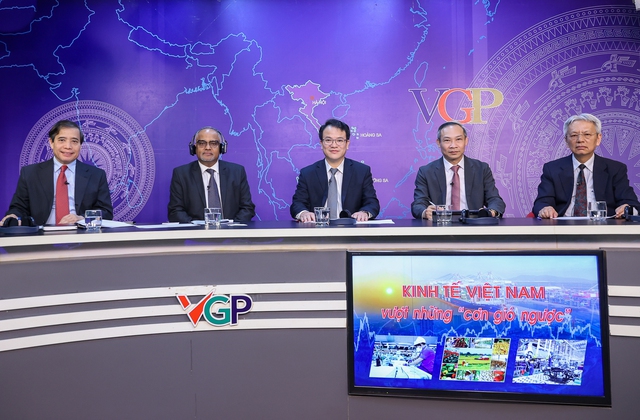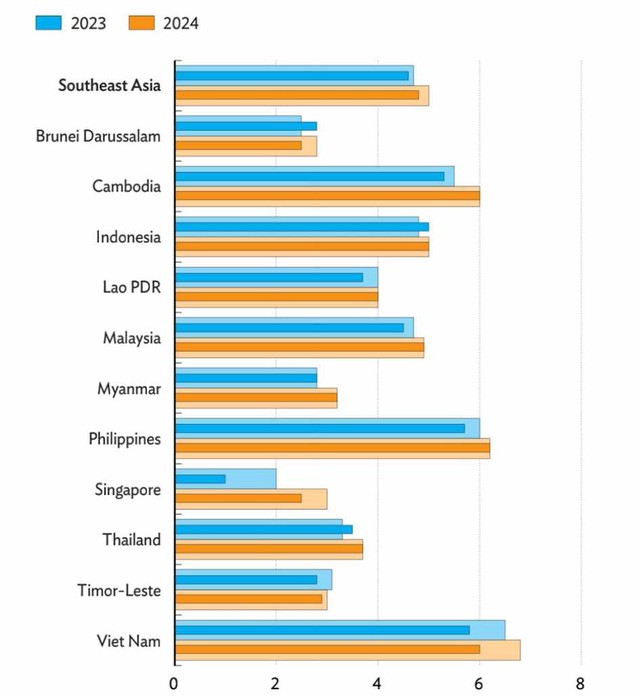ADB Country Director hails Viet Nam's proactive policy responses
VGP - The Asian Development Bank (ADB) appreciates the Vietnamese Government’s proactive policy responses conducive to macroeconomic stabilization and socio-economic development.

Country Director of the Asian Development Bank ADB for Viet Nam Shantanu Chakraborty (second to left) at the talk themed "Viet Nam's economy overcoming the headwinds" at the headquarters of the VGP, Ha Noi, October 5, 2023 - Photo: VGP
Country Director of the ADB for Viet Nam Shantanu Chakraborty made the above statement while assessing the Government's leadership and governance of socio-economic development over the past months.
At the talk themed "Viet Nam's economy overcoming the headwinds" that took place at the headquarters of the VGP in Ha Noi on October 5, Shantanu Chakraborty noted that ADB's recent projection released in September 2023 indicated that Viet Nam would still leading growth in Southeast Asia at 5.8 percent for 2023 and 6 percent for 2024.
Data for third quarter of 2023 showed GDP growth of 5.3 percent quarterly, bringing the 9-month year-on-year growth rate to 4.24 percent.
In terms of macroeconomic policies involved fiscal and monetary measures, so far, the government has moved in the right directions and a timely fashion, the ADB Country Director highlighted.
Looking at the global and regional outlook, growth slowed down for most economies in Southeast Asia.
However, robust domestic demand and continued recovery of the services sector—particularly tourism—have contributed to better job and income prospects, keeping growth close to its long-run average for the whole Southeast Asia region, including Viet Nam.
In Viet Nam, strong domestic consumption, supported by moderating inflation, has lifted the service sector expansion by 6.3 percent and contributed 2.9 percentage points to the total 4.3 percent growth over the last nine months of 2023.
Remarkably, agriculture sustained strong growth at 3.4 percent following a pickup in commodity prices.
Stable foreign direct investment (FDI) disbursement was estimated at over US$15 billion during January-September, a slight increase year-on-year from 2022.

ADB's recent projection released in September 2023 indicates that Viet Nam would still leading growth in Southeast Asia at 5.8 percent for 2023 and 6 percent for 2024 - Source: ADB
Measures proposed for Viet Nam to overcome headwinds
According to Shantanu Chakraborty, while Viet Nam's economy has shown resilience in the context of global economic uncertainty, near-term prospects through 2024 and beyond are still facing heightened risks coming from the external environment.
In this context, it is crucial that the policy makers stay vigilant for timely responses, while efforts to boost the domestic economy both through short-term support measures and longer-term reforms, he suggested.
Fiscal stimulus measures should be prioritized because Viet Nam still has fiscal room. Public debt is well controlled at around 38 percent of GDP as of end-2022.
Viet Nam should accelerate the disbursement of a sizable public investment, around US$30 billion. This will directly support contracting industries such as construction and mining, and provide more employment opportunities.
It is critical to swiftly implement the 2 percent VAT cut and the VAT reduction should be implemented until the end of 2024, instead of only 6 months in 2023.
The government could also consider social safety measures to support the labor market, including unemployment allowance or reskilling incentives.
Monetary policy has also been accommodative, with four rounds of policy rate reduction in attempts to reduce borrowing costs for businesses. Exchange rates have also been flexibly managed at stable level.
Coordinated policy can effectively support economic recovery, considering relative price stability and weak demand.
In the near term, monetary policy should be accommodative and fiscal policy expansionary. Slow credit growth indicates that monetary policy loosening must be closely coordinated with fiscal policy implementation to effectively boost economic activities.
For long-term sustainable development, the government should double down on reform efforts to improve the business environment, especially in the context of green transitioning, addressing climate change and private sector development, and building on continuous strength in FDI attraction./.
